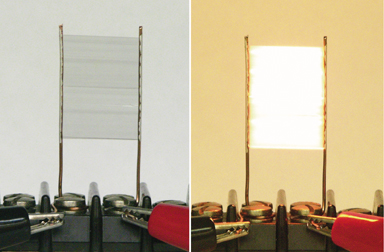Fine Fabric: New, fast way to make sheets of nanotubes
Scientists have come up with a way to efficiently produce thin, transparent sheets of carbon nanotubes that are several meters long and could have applications as diverse as automobile windows that double as antennas and electronic displays that can bend like paper.

Nanotubes, minuscule cylinders of carbon atoms just a few nanometers across, are lightweight and stronger than steel, and they can conduct electricity. Now, Ray H. Baughman of the University of Texas at Dallas and his colleagues have developed a way to produce sheets of nanotubes with an ease and speed that could make their manufacture commercially viable.
“There’s nothing like this out there,” says Edwin L. Thomas, a materials scientist at the Massachusetts Institute of Technology.
To make the sheets, the researchers first cultivate a dense forest of nanotubes on a surface, such as glass, coated with a catalyst that stimulates nanotube growth. They then press an adhesive strip against an edge of the forest and pull away the strip. Nanotubes that adhere to the strip rise from the forest, snagging their neighbors and pulling them along, similar to the way in which plastic monkeys form a chain in the children’s game Barrel of Monkeys.
The team has also developed an automated way to roll up the sheets as they’re produced. In some experiments, which hint at mass-manufacturing possibilities, the researchers created nanotube sheets at a rate of 7 meters per minute, and they say that they haven’t come up against a limit in the sheets’ length. The researchers describe their technique in the Aug. 19 Science.
The gossamer sheet, just 18 micrometers thick, weighs 0.4 percent as much as the same area of Mylar. Eighteen bonded nanotube sheets produced a material that is stronger than sheets of equal weight made of Mylar, of high-strength steel, or of most aluminum alloys, says Baughman.
A nanotube sheet compacts to a thickness of about 50 nanometers, or about 1/1,000th the thickness of a human hair, after it’s attached to a surface, saturated with a liquid, and allowed to dry. These flexible films have been used as the glowing element of an incandescent light and as a component of electrodes for solar cells, says Baughman.
By sandwiching a sheet of nanotubes between two 5-millimeter-thick plates of Plexiglas and zapping the assembly with microwaves, Baughman and his colleagues produced a structure that retained its transparency—a characteristic that could prove useful for making automobile windows that include invisible antennas or heating elements.
The new technique avoids the contaminants that often appear in nanotube sheets fabricated by other methods, Thomas says. This purity would be a plus for electronic uses, he notes.
Being electrically conductive, the nanotube sheets may prove useful for basic neuroscience measurements, such as tracking the electrical activity of individual neurons or of ensembles of the cells, says Mario I. Romero, a neuroscientist at the University of Texas Southwestern Medical Center in Dallas. Because the sheets consist of just carbon, they may also serve as scaffolding for human tissues grown as implants, he notes.







